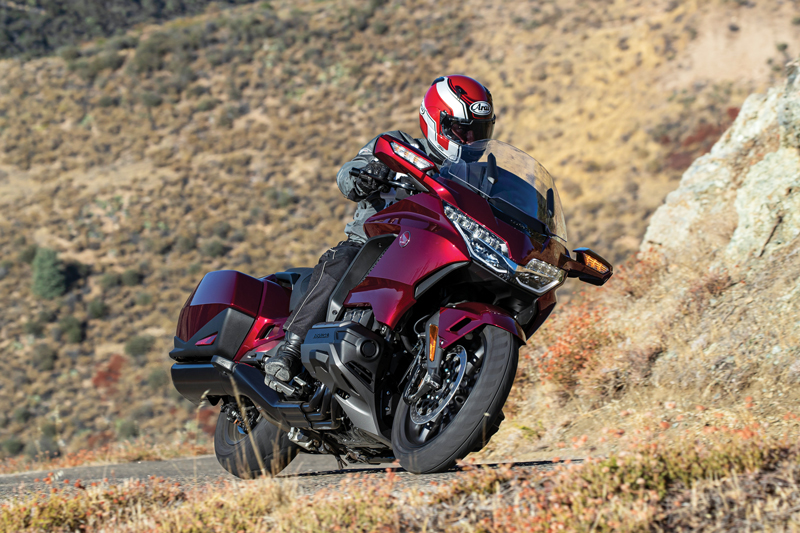
When Honda introduced a pair of radically new Gold Wings for 2018, its strategy was quite clear. After 17 model years, everyone who wanted a luxotourer like the previous GL1800 model already had one, and at 900-plus pounds, it was hardly a good starting point for adding modern features like an electric windscreen, computer-controlled adjustable suspension or an automatic dual-clutch transmission (DCT). No, to get the attention of riders across the board (not just younger ones), the new Wing had to start from a lighter, more compact place with a clean sheet of paper, and then add the latest electronic and digital features that contemporary riders expect. The result is a pair of bikes so evolved from their predecessor that some marketing types at Honda didn’t even want to call them Gold Wings.
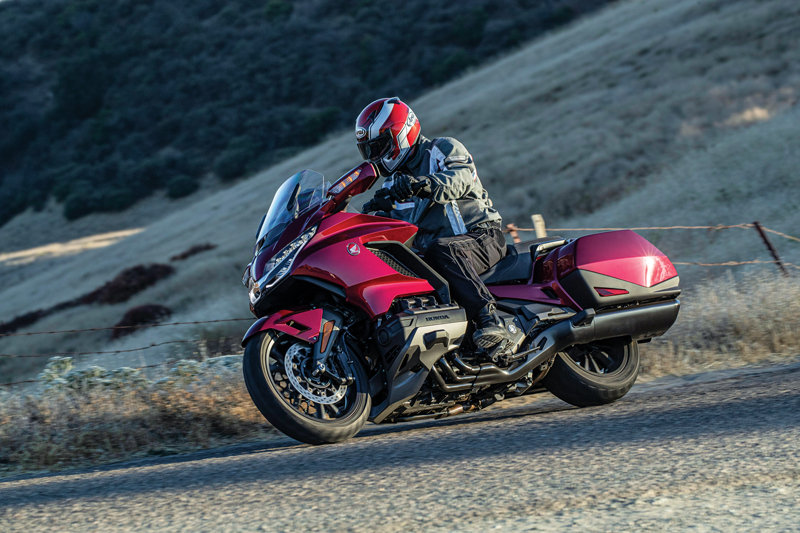
Mark’s Gear
Helmet: Arai Regent-X
Jacket: Olympia Motosports Switchback 2
Pants: Olympia Motosports Airglide
Boots: Dainese Long Range
Job one was to put the bike on a serious diet with a new lighter aluminum frame and single-sided swingarm, shrink-wrapped, flat opposed 6-cylinder engine and sculpted, more aerodynamic bodywork, seats and luggage, all of which and more shaved off about 79 pounds and four inches of overall length from the Navi/ABS top-trunk equipped model. Now called the Gold Wing Tour, it weighs just 831 pounds wet with a manual transmission, and the new standard Gold Wing sans top trunk is even lighter at a claimed 787 pounds, or 808 pounds for the automatic DCT version tested here. Rider was among the first to ride the new Wings, from camouflaged pre-production units at Honda’s Twin Ring Motegi racetrack in Japan to a full two-up test and big-mile shootout with a BMW K 1600 GTL in the U.S. You can find our numerous ride reports and scads of technical details on the bikes in Rider’s 2018 issues and in our First U.S. Ride Review here.
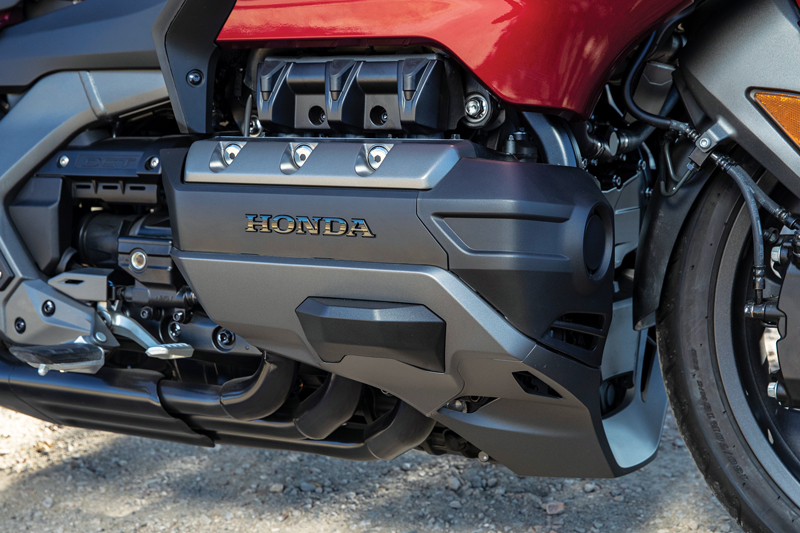
AWOL in all of that coverage is a test of the new lighter, less expensive standard Gold Wing, in some ways the successor to Honda’s first flat-six Gold Wing bagger, the 2013 F6B. Like the new standard, the F6B had a shorty windscreen and a smooth cowl between the saddlebags instead of a top trunk, and styling changes like a gunfighter seat gave it some bagger influence. In retrospect Honda went a bit too far by stripping the F6B of cruise control, ABS, reverse, windscreen adjusters and more, which brought the weight and price down significantly but turned off touring riders who otherwise liked the idea of lighter Gold Wing. Cruise control was added two years later, but then it was only a short time before the new 2018 Wings sent the F6B packing.
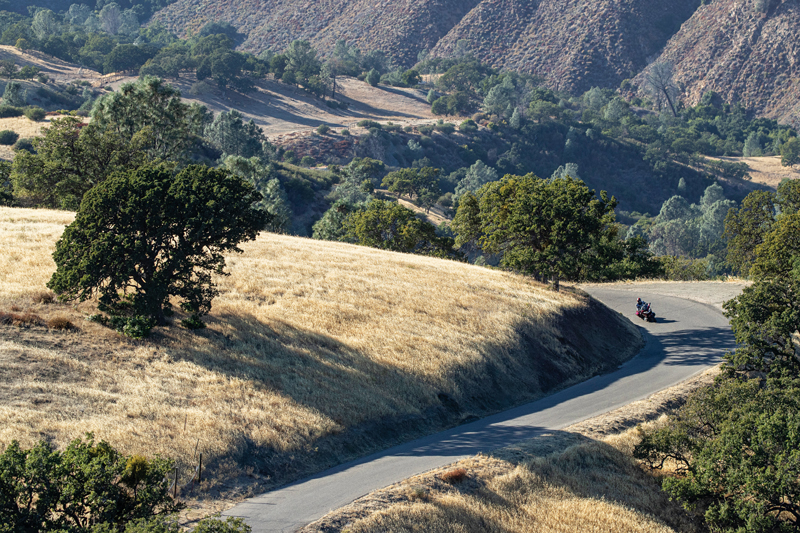
In addition to offering more performance overall, the new standard rectifies every F6B slipup and then some by retaining the Tour model’s cruise control, powerful linked brakes with C-ABS, electric windscreen, four riding modes (Sport, Tour, Eco and Rain), complete infotainment system with Apple CarPlay, GPS navigation, heated grips and more. Yet our 2019 Gold Wing test bike — even with its optional automatic DCT gearbox — is still a few pounds lighter than the F6B. At 30 liters each versus the F6B’s 22, the standard’s saddlebags are slightly larger, too, though they are inefficient side loaders and the interiors are quite small and convoluted — plan on getting the optional rear carrier or even the Tour’s 50-liter top trunk (it can be retrofitted) for two-up tours.

Besides the shorter electric windscreen and absent top trunk on the standard, some important differences between it and the Tour jump out on the first ride, most notably in the suspension. Although the standard has remotely adjustable rear spring preload, neither the spring strut in the dual-wishbone front end nor the rear shock offer adjustable damping, and both the spring and damping rates are quite stiff. While this helps the lighter, more responsive bike hustle down a twisty, bumpy road like a sport tourer, it beats up the rider around town and commuting in a very un-Gold-Wing-like way, enough to make me seriously miss the front/rear Electric Damping Adjust keyed to the riding modes on the Tour. Changing riding modes still affects throttle response, ABS and the shift points of the DCT (if equipped), but there’s no softening or stiffening of the suspension when going from Sport to Tour/Eco/Rain mode or vice versa. Moreover, the location of the remote knob makes it very difficult to change the preload setting.
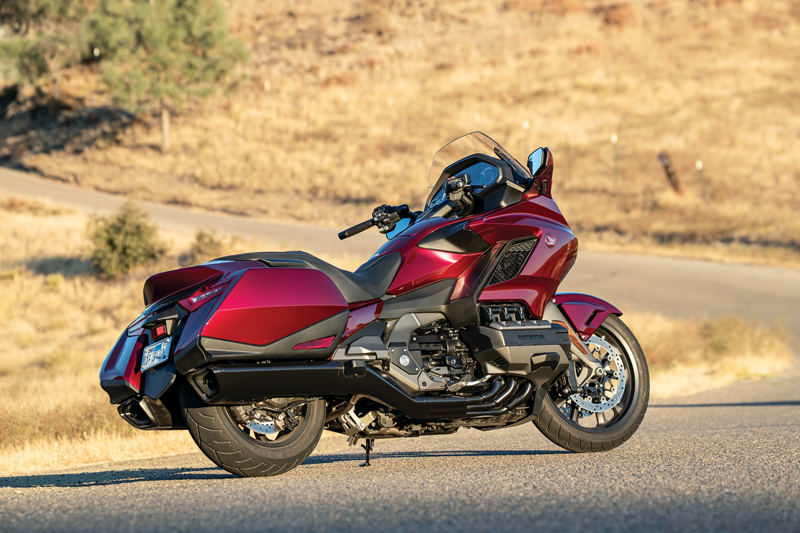
DCT is a handy feature at times since there’s no clutch lever or foot shifter to deal with (although you can have the latter if desired), and the latest version in the Wings upshifts automatically or manually quite smoothly and has seven speeds. I can’t say I’m a big fan though, because I frequently use a manual clutch lever during low-speed maneuvers (particularly when riding two-up) to feather the power delivery and match revs when downshifting. Regardless of riding mode, with DCT the power “tip-in” starting out from a stop is too abrupt, especially when you have to turn tightly as well, and downshifting automatically the DCT doesn’t fully match revs — it feels a bit like a novice rider just learning how to change down. It would seem an easy choice to save the $1,200 and get the base bike with 6-speed manual transmission, but then you also lose the DCT’s reverse and forward “Walking” modes, which are game changers on a bike that weighs around 800 pounds. Both are activated with the up/down DCT thumb shifters on the left handlebar and help greatly with parking maneuvers.
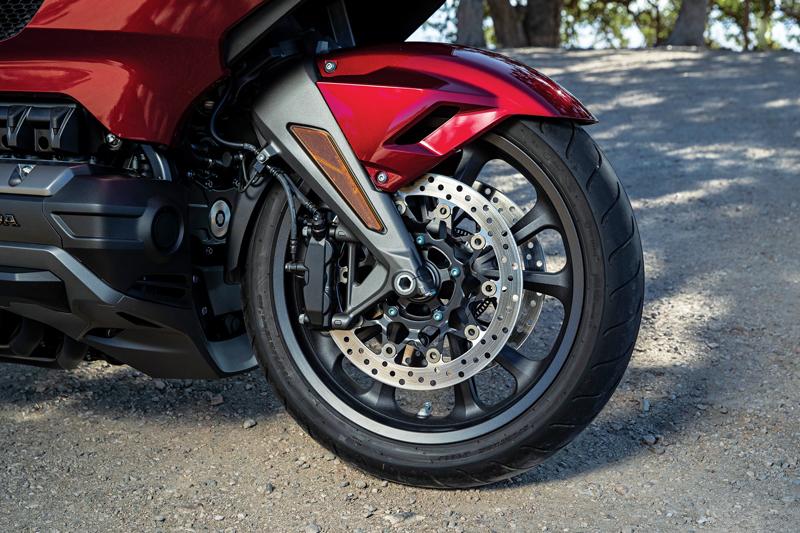
Several nice-to-have features found on the Tour are optional on the standard, like a centerstand, rear speakers, top box and taller windscreen. Other Tour goodies aren’t available for it, like Honda Selectable Torque Control (HSTC, or traction control), and Honda’s factory heated seats. A CB radio is not on the standard’s accessory list either (partly because the antenna installs in the Tour’s top trunk). With Eco and Rain modes available to soften the power delivery, however, I can’t say I missed HSTC, and the aftermarket can provide that other stuff.
Riding the standard Gold Wing feels a lot like taking off a heavy backpack after a hike. With 44 pounds less weight than a Tour to schlep around (and more than 100 pounds less than a 2017 Navi/ABS model!), the standard Wing accelerates more briskly with a deep growl from its smoother, broader powerband, and there’s no tail trunk wagging the dog in corners, so it handles more fluidly as well. I still find the new front end heavy and vague at low speeds, particularly on loose surfaces, but the bike’s stability on the highway and in corners fast and slow is unparalleled. Braking is linear and impressively forceful, the engine is silky smooth at all times and seating comfort and wind protection are excellent, even with the shorter windscreen. It’s easiest to hear the infotainment system with the screen in the highest position, and easier still with a Bluetooth wireless headset, which is required to enable Apple CarPlay along with an iPhone.
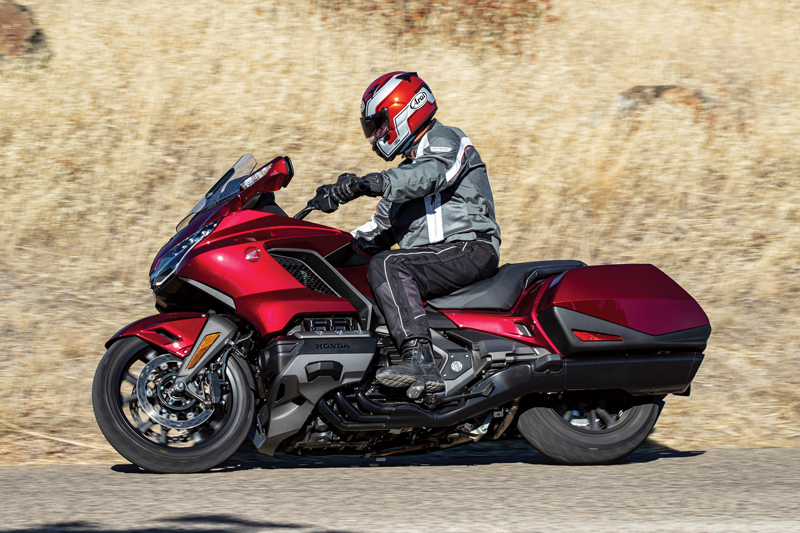
Although the Wing’s basic phone, GPS and music setup is comprehensive, easy to use and compatible with Android or Apple phones, the large TFT display is not a touchscreen, and much of the system is frustratingly locked-out when the bike is in motion. If you have an iPhone, Apple CarPlay fixes all of that by bringing a headset(s) and Siri voice commands to bear, and though the handlebar controls have a bit of a learning curve, once you figure them out there’s very little you can’t do with the phone, GPS or audio, even in motion. CarPlay also seems to have better fidelity than the base system, too.
Honda didn’t call the new standard Gold Wing the “Sport” because it might alienate the bagger crowd, but that’s the nickname it has earned around here. If you regularly ride two-up, think twice, as the hard-to-adjust stiff suspension and lack of luggage capacity are issues. But a solo rider who likes the sheer presence of the Wing and the standard’s sleek looks can rack up the miles and have a lot of fun on this bike.
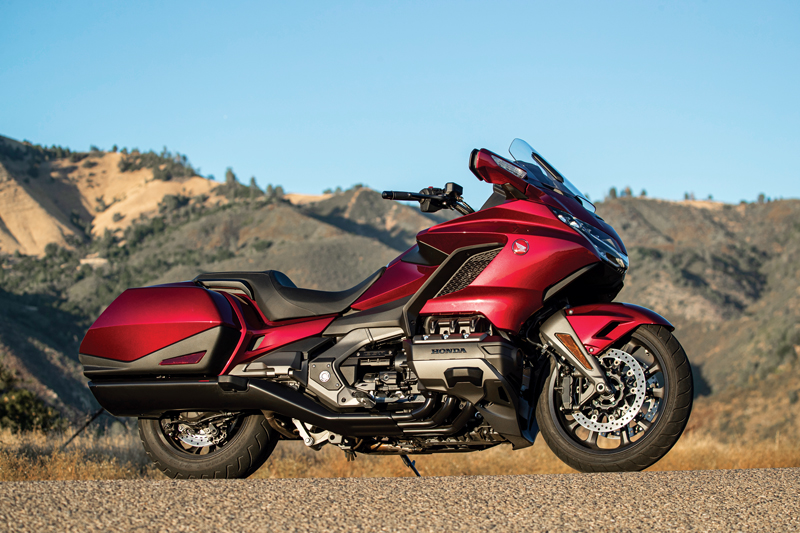
2019 Honda Gold Wing DCT Specs
Base Price: $23,800
Price As Tested: $25,000 (DCT model)
Warranty: 3 yrs., unltd. miles, transferable
Website: powersports.honda.com
Engine
Type: Liquid-cooled, longitudinal opposed flat six
Displacement: 1,833cc
Bore x Stroke: 73.0 x 73.0mm
Compression Ratio: 10.5:1
Valve Train: SOHC, 4 valves per cyl.
Valve Adj. Interval: 24,000 miles
Fuel Delivery: EFI w/ 50mm throttle body
Lubrication System: Wet sump, 3.9-qt. cap.
Transmission: 7-speed automatic/manual DCT w/ Walking mode & reverse (as tested)
Final Drive: Shaft, 1.795:1
Electrical
Ignition: Full transistorized
Charging Output: 1,560 watts @ 5,000 rpm
Battery: 12V 20AH
Chassis
Frame: Aluminum tubular & box-section double cradle w/ single-sided cast aluminum swingarm
Wheelbase: 66.7 in.
Rake/Trail: 30.5 degrees/4.3 in.
Seat Height: 29.3 in.
Suspension, Front: Dual-wishbone w/ Showa shock, no adj., 4.3-in. travel
Rear: Pro-Link w/ Showa shock, remote adj. spring preload, 4.1-in. travel
Brakes, Front: Dual 320mm discs w/ 6-piston opposed Nissin calipers & C-ABS
Rear: Single 316mm disc w/ 3-piston floating caliper & C-ABS
Wheels, Front: Cast, 3.50 x 18 in.
Rear: Cast, 5.00 x 16 in.
Tires, Front: 130/70-R18
Rear: 200/55-R16
Wet Weight: 808 lbs. (as tested)
Load Capacity: 451 lbs. (as tested)
GVWR: 1,259 lbs.
Performance
Fuel Capacity: 5.5 gals., last 1.0 gal. warning light on
MPG: 86 AKI min. (low/avg/high) 38.8/39.7/41.8
Estimated Range: 219 miles
Indicated RPM at 60 MPH: 2,000









Honda Drop the ball with the ST 1300 Had they equip the bike with options it would’ve competed against the BMW RT 1200 but with the Honda you were lucky to have a spare key that was it ,
And then Honda took the st1300 and turned it into ctx1300 we all know how that turned out,
I have met several wing riders who are getting 50+mpg on their 2018. So I dont agree with your mpg numbers.
50+ mpg not on my 2018 gw base model…
“Gold Wing Sport” was / is the 2014-2016 Gold Wing Valkyrie F6C really, so that wouldn’t be applicable to this model here. I guess just plain “Gold Wing”, versus “Gold Wing Tour”, is correct. We’ll never see a new F6C in the current style, the last F6C didn’t sell well (but we owners love them anyway).
I just returned from Bike Week in Daytona and as long as I keep the speed under 75 I would Average around 50 to 52.
When returning home from Bike week we ran harder,around 75 to 85 and got around 42 to 44!
I too found downshifts with the DCT harsh at first. Not now after several thousand miles. They’re smooth as silk. Plus I regularly get 50+ MPG. On the highway above 60 MPH mileage drops into the mid 40s. The DCT equipped Wing is pure magic and low speed maneuvers in traffic are contrary to the reviewers experience absolutely no problem.
I bought a holding in 1977 and took from NY to California and got 50 mpg, then a year later NY to Co and while going through Neb around 1 to 2am I ran 100mph for one hour with a Porsche following me and we both pulled in a gas station the same time and opened or gas caps and heard a swishing sound then we looked a each other and laughed. I was getting 25mpg.
The DCT Wing’s low speed handling manners are impeccable and the DCT downshifts are smooth as silk. I will grant that starting from a stop in sport mode requires a deft hand. Makes me wonder what you were riding.